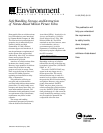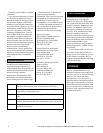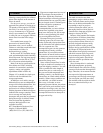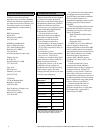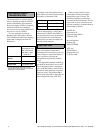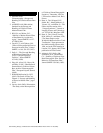
Safe Handling, Storage, and Destruction of Nitrate-Based Motion Picture Films • H-182 (ENG) 2
There are several methods to identify
a film base.
You can prepare and analyze a sample
of a film base by infrared absorption
through an analytical laboratory using
the procedure outlined in ISO 10682.
Another test to distinguish nitrate film
from safety film is to punch or cut a 1/4-
inch diameter sample from the film and
place it in a test tube or small bottle
containing trichlorethylene. You will
need to shake the liquid to ensure that
the sample is completely immersed.
Cellulose nitrate films will sink in the
liquid and safety films will float to the
surface. Cellulose nitrate films that have
started to deteriorate may change
density and may not sink in the
trichlorethylene. Always perform this
test in a well ventilated area to minimize
exposure to trichlorethylene. Dispose of
used trichlorethylene as a hazardous
waste.
In addition to the inherent hazards
associated with the flammability of
cellulose nitrate film, decomposition of
the film also can present safety concerns
during its storage, handling,
transportation, and destruction. The
deterioration of cellulose nitrate films
can be divided in to five distinct stages:
DETERIORATION
Stage 1 Film has an amber discoloration with fading of the image. Faint nox-
ious odor. Rust ring may form on inside of metal film cans.
Stage 2 Emulsion becomes adhesive and the film tends to stick together dur-
ing unrolling. Faint noxious odor.
Stage 3 Portions of the film are soft, contain gas bubbles, and emit a noxious
odor.
Stage 4 Entire film is soft and welded into a single mass, the surface may be
covered with viscous froth, and a strong noxious odor is given off.
Stage 5 Film mass degenerates partially or entirely into a shock sensitive
brownish acrid powder.
Deteriorated films in the first two
stages are photographically
reproducible. Unless you have expertise
in determining the characteristics of
nitrate films in various stages of
decomposition, do not unroll the films.
For help determining the historical
value of any material on nitrate base,
contact a local historical film
association, or one of the following:
Library of Congress
Motion Picture, Broadcasting and
Recorded Sound Division
Washington, D.C. 20540-4800
Phone (202) 707-5840
Fax (202) 707-2371
National Archives and Records
Adminstration at College Park
8601 Adelphi Road
College Park, MD 20740
Phone (301) 713-6700
Fax (301) 713-2371
Federation of International Film
Archives (FIFA)
FIFA Secretariat
rue Franz Merjay 190
1180 Bruxelles/Brussels
Phone 32-2-343-06-91
Fax 32-2-343-76-22
As cellulose nitrate film decomposes, it
can release nitric oxide, nitrogen
dioxide, and other gases. These vapors
will accelerate the decomposition of the
remaining film base. Depending on the
airborne concentration, vapors from
decomposing film may be irritating to
your eyes, nose, and throat. Providing
adequate ventilation reduces the
airborne concentration of the vapors and
ensures that exposure limits established
by the Occupational Safety and Health
Administration (OSHA) or the
American Conference of Government
Industrial Hygienists (ACGIH) will not
be exceeded.
To avoid contact with your skin and
eyes, and to reduce the possibility of
injury, always wear impervious gloves,
such as rubber or neoprene, and eye
protection when handling decomposing
cellulose nitrate film.
Because cellulose nitrate films are
flammable and there are decomposition
concerns, you need to store and manage
them in a safe manner that limits
decomposition. You can preserve or
duplicate cellulose nitrate films until the
third stage of decomposition. Cellulose
nitrate films that have reached the third
stage of decomposition, or that have no
historical value, should be destroyed at
an authorized facility.
.
SAFE HANDLING
PRESERVATION AND
STORAGE



